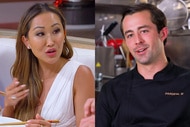
Create a free profile to get unlimited access to exclusive videos, sweepstakes, and more!
The 7 Most Burning Restaurant Tipping Questions, Answered
Tip (or don’t tip) with newfound confidence thanks to intel from the experts.

Let’s all just confess that half the time we’re totally guessing on the proper tipping etiquette in restaurants. Right? (This is a safe space…) Well, you no longer need to fake your way through dining-out life, because we hit up some pros for definitive answers to some of our most pressing/awkward tip-related head-scratchers.
1. Tipping on Tax: Yes or No?
To tip on the pre- or post-tax total, that is the (ever-debated) question… Some diners opt to ignore the funds the restaurant is shelling out to Uncle Sam and thus base their tip on the pre-tax amount. Others just look at that final total and calculate their tip percentage from there—quite possibly simply because the eye is trained to head for the very bottom of the bill. “Most people tip based on the post-tax amount,” says Kyle Pepperell, general manager of Boka in Chicago. But there’s no hard-and-fast rule that’ll get you tossed into tipping jail either way.
2. Tip on Your Whole Fancy Bottle of Wine?
If you decide to splurge on a bottle (or four) of $200 wine with dinner, should you tip on the entire cost of the vino? “The service will be the same whether it’s a $10 bottle or a $1,000 bottle,” explains Sarah Blau, general manager of Aster in San Francisco. “But with the more expensive bottle there’ll be extra glassware and decanting. You’re also paying for the education that goes into serving you that bottle.”
Plus, there’s a very real chance your server may be required to share a portion of their tips with other restaurant support staff. “That can be set as a percentage of their sales, which means that the server is tipping out on that whole bottle at the end of the night,” says Pepperell. So basically, if you’re going big on the wine, don’t go small on the tip.
3. Where to Tip When You (and Your Tab) Get Moved?
You have a drink at the bar, then move to your table and your beverage tab travels along with you. Who do you tip for that pre-dinner cocktail? “It’s fine to leave the tip at the bar and then not count that drink when you’re tipping on the total of your dinner bill,” Pepperell states. “The server wouldn’t expect to be tipped on that when transferring.” Just be sure to roll in with some cash to leave behind for your trusty bartender at the start of the evening.
4. What If You Score Freebies?
Say it’s your lucky day and the chef sends out a comped extra course or drinks on the house (oh, you and your connections…)—keep in mind that those magical freebies should also be tipped on. “It’s still work to send something extra out, so that should still be part of the tipping equation,” Blau says. And someone was being nice to you, so you can quite literally pay it forward.
5. Are We Tipping for Water Now?
Don’t panic: That’s a hard no. If you’re sitting at the bar waiting for your table and the friendly mixologist serves you up a glass of her finest tap water, you definitely don’t need to tip for that. “The bartender is not expecting it,” assures Pepperell. Now, go forth and hydrate with ease…
6. What If the Service Is Straight-Up Crappy?
If you feel like you had a meal riddled with bad service, what’s the right amount of tip to leave behind? “Fifteen percent would be the minimum for horrible service, just because other people in that tip pool are relying on that tip,” says Pepperell. “It’s better to let management know you’ve had a bad experience than to take it out of the tip.” So consider complaining with your voice instead of your wallet.
7. Is No Tip Ever an Option?
Technically, it’s always your decision whether to tip or not, but if a situation ever arises where you’re contemplating leaving zero tip, ponder it carefully. The restaurant could be a pooled house (where tips are shared among all the staff). “Then you’re also affecting other people—the person who’s running your food, the person who’s pouring your wine, the person who’s polishing your food,” Blau points out. Not to get you all hung up on potential collateral damage, but it’s always wise to just contemplate the big picture before scribbling that scary “0” on the tip line.


























